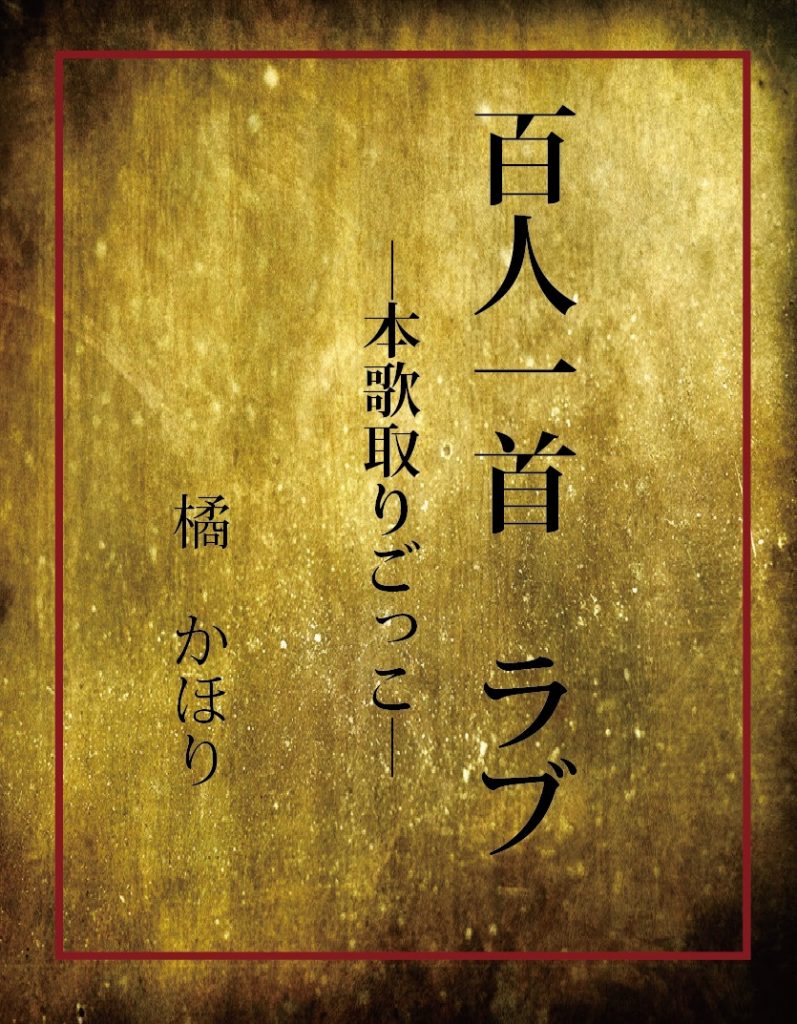Hyakunin Isshu Love
This post is also available in:
 日本語 (Japanese)
日本語 (Japanese)  Français (French)
Français (French)
Hyakunin Isshu Love
To purchase a printed book (print on demand), click on the image below to jump to the URL.
(e-book + print-on-demand)
Introduction
Kaori Tachibana
“Hyakunin Isshu Love" (500 yen tax included)
“Hyakunin Isshu Love" is divided into the first chapter “Hyakunin Koi Love" and the second chapter “grandmother’s proverb says".
First of all, I will briefly talk about “Hyakunin Isshu Love" in the first chapter, it is the first collection of Honkatori from a collection of “Ogura Hyakunin Isshu" (Single Songs of a Hundred Poets). Honkatori, one of the rhetoric methods of Waka (tanka poetry) is an elaborate adaptation of a Japanese poem which is that was widely used for “New Kokin Wakashū" etc. Honkatori is a rhetorical method that uses characteristic phrases of old songs, underlies a part of the classic, such as stories, and also based on the idea of Chinese poetry. By using it, we will develop a new world further on the world that old songs have, and will create a multilayered world for songs. Let me give you an example.
There is a Waka sang in “Ogura Hyakunin Isshu" at No. 94: From Mount YoshinoBlows a chill, autumnal wind, In the deepening night. Cold the ancient hamlet is;–Sounds of beating cloth I hear. Actually, this Waka has the original verse poem. It is “Kokin Wakashū" 's “At Mount Yoshino white snow would be piled, because colder the ancient hamlet is" While using “Mout Yoshino" and “Cold the ancient hamlet" in “Kokin Wakashū", the place called “Mout Yoshino" is the same in “Ogura Hyakunin Isshu", but the season is from winter to autumn, by adding the scene of “beating cloth " which prepares for winter, the landscape of “Mout Yoshino" further captures not only the scenery but also the mind by incorporating hearing into songs from the scenery mainly based on tactile sense. It is deepening into the desolation lyrics. The effect of amplifying the world of 94 song comes out while making the world of the song of “Kokin Wakashū" duplicated in the reader’s brain. In this way, “Hyakunin Isshu Love" is the book of one hundred contemporary tanka with Honkatori, a rhetoric method which had already existed before the era of “Ogura Hyakunin Isshu". You can think of it as one of ways of writing tanka. Now, why Honkatori, because I do not see this rhetoric much in modern tanka world. This time as traditional techniques I also use customary epithet, Kakekotoba (paronomasia), associated word, Taigendome (ending a sentence with a noun or noun phrase), etc. besides taking Honkatori. For example, the tanka “Hisashi no" of my 33rd tanka is a customary epithet of “light". The word “Aki" (Autumn) of the first tanka “Autumn evening" is paronomasia for “boring". As an associated word, “thousand" of 23rd tanka “one thousand" and “one" of “one autumn" are ones, because “thousand" and “one" are words that are related to each other. As Taigendome, the phrase stoppage ends with 'noun’ in 'Dusk in autumn’ of tanka 70.
When you stop using Taigendome (ending a sentence with a noun or noun phrase), you get a suggestiveness. Also, although I am not using this time, there are also rhetorical and introductory rhetoric methods and songs as well as other songs such as Chôka (a long poem in Japanese). There is a history of poetry which has produced so many things like this. Waka 's rhetoric method has been in the era of “Man’yōshū" a long time ago and has come to be seen now. It is a too much pity that we do not use the rhetoric method that has been honed in this history. How can I improve the world of Tanka by using this rhetoric method, and how much more depth and fun will be increased. Those who have this book will know the charm of this old rhetoric and try to guess the number of “Ogura Hyakunin Isshu" from tanka of this book .




